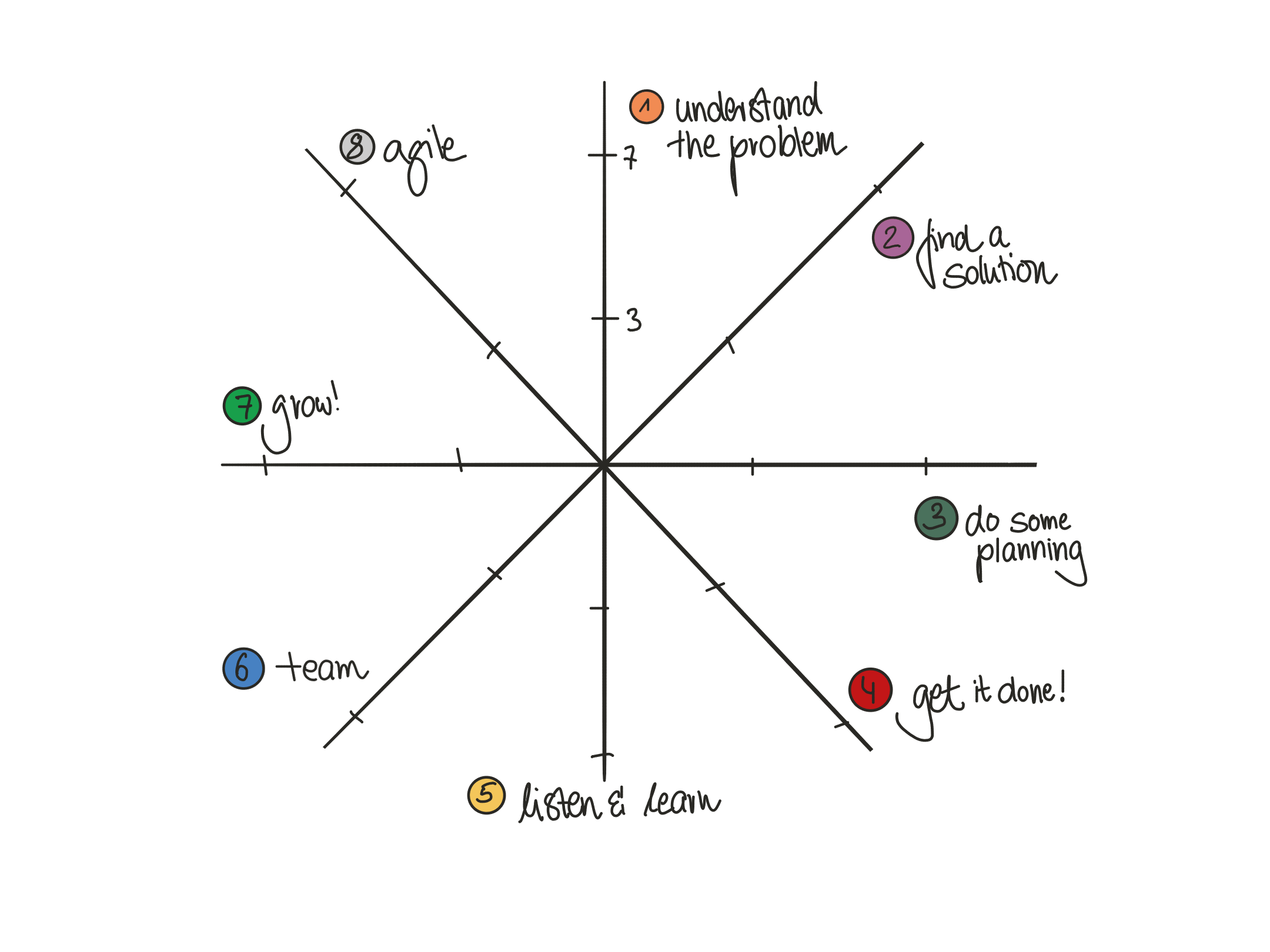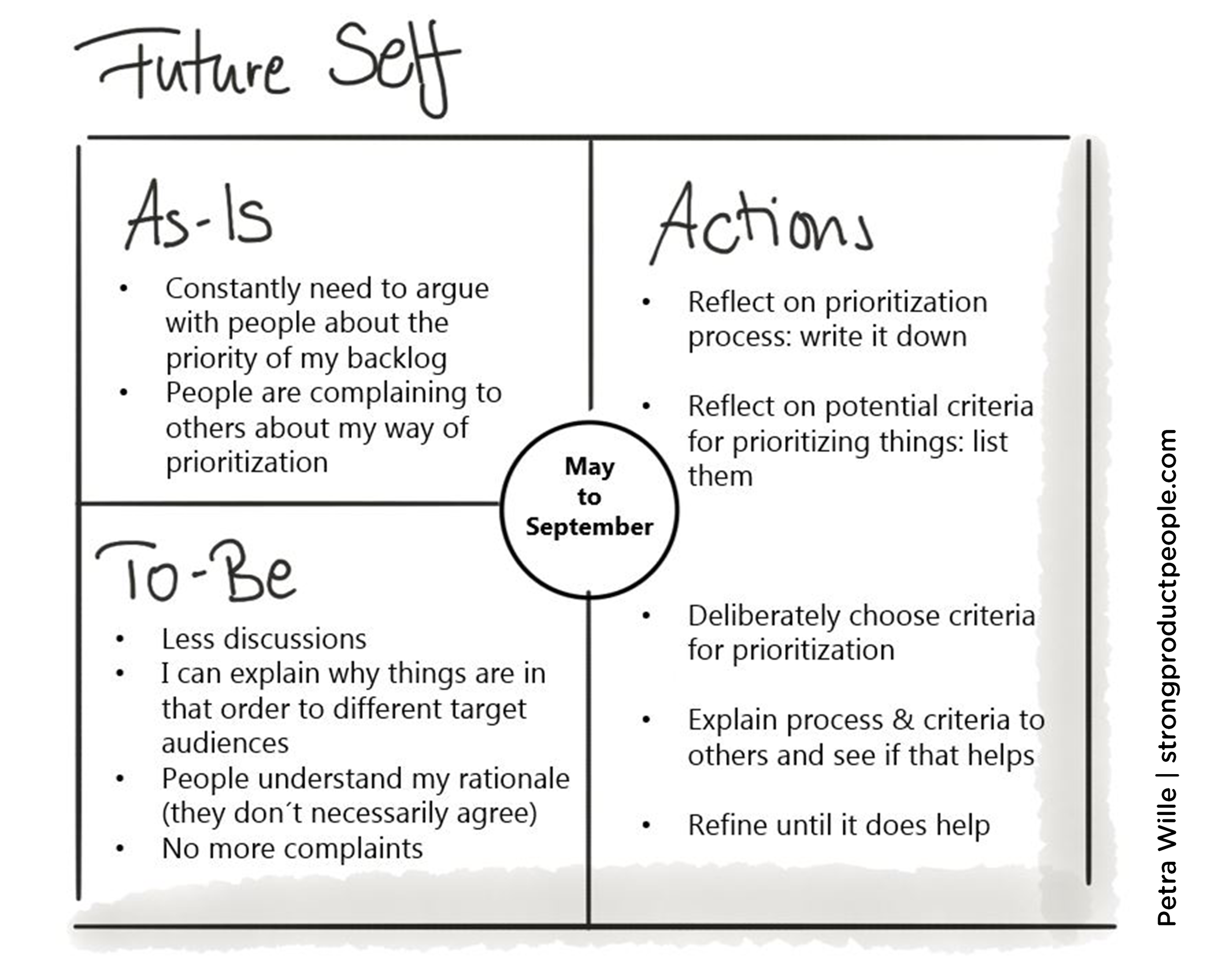How to use the PMwheel as a Self-Assessment Tool for Product Managers
I created the PMwheel back in 2016 to give more structure to my coaching sessions with PMs from all over the globe. It’s proved so useful that I’ve been using it ever since in my work with my clients.
I realized that it is a framework that many of my former coachees are still using long after they have left the initial company. They are mainly using it as a tool for self-assessment in times where there is no line manager helping them with their personal growth. It became a compass for many people that helps them navigate their product career. So I decided to share it with a much bigger audience to help even more people.
If you are a product manager seeking guidance, the PMwheel will help you to answer questions like “What should my next personal and professional development topic be?”
The eight dimensions of the PMwheel and what they are all about
I believe a good product manager should be able to:
Listen to their users/customers/market to understand their problems and how they could possibly solve them (That is generating the value!)
Conduct several experiments and prototypes to test their assumptions/hypotheses and various solutions before they actually build the product (Or, as Marty Cagan explains, they need to minimize the risk of building the wrong thing in a beautiful way)
Deliver value and test if people are actually using/buying their product (product-market fit)
Maximize value but minimize the effort to build the actual solution and make sure the winning solution(s) can be built by the team in a reasonable amount of time
Deliver the product and optimize (or even innovate) it based on customer feedback.
In the product world, you’ll find that these product manager activities are given all sorts of fancy names, including design thinking, product discovery, user research, and more. However, in the end, it all boils down to what product managers do.
I have decided to use eight key activities in the PMwheel assessment to allow PMs to talk about what they do and to help them rate themselves. Let’s take a look at the activities themselves as illustrated in the following PMwheel graphic:
The 8 activities that form the Product Manager's role
Understand the problem: Is the product manager aware of the underlying user problems of the product they are working on? Do they understand the motives, issues, and beliefs of these people? And have they thought about what the needs of the company/organization are when it comes to creating this product?
Find a solution: Did they find good problems to solve? Great! Can they come up with some possible solutions and experiments for testing them?
Do some planning: Whether you're a fan of good old roadmaps or you know the latest Agile planning tricks, a PM must have a plan and a story to explain what’s next.
Get it done! Every PM needs to know how to work with their product development team to get the product out to the customer.
Listen & learn: Once you have released something new, you will want to observe if and how people are using it and iterate on the learnings to improve the current status.
Team: How good is the PM when it comes to teamwork? What do they know about lateral leadership and motivation of teams?
Grow! Is the PM investing some time in their personal growth as a product person?
Agile: Are they just living in the Agile world or do they fully understand Agile values, principles, and ways of working?
The first five dimensions listed above are specific parts of the product-development process, while the remaining three are more general and not specific to product development. There is a detailed version of the PMwheel along with many guiding questions that can be very helpful in a career conversation available for download here.
Examples of some of the questions are:
Listen & learn:
Can they talk about the current performance of their product at any given time?
Can they describe experiments and quick testing methods to improve and refine their product in short cycles?
Get it done:
Can they describe how they keep stakeholders in the loop while developing things?
Can they describe their team’s take on software quality?
How do they make sure everything works well?
How to Use the PMwheel as a Tool for Self-Assessment
To assess yourself using the PMwheel, answer all of the questions for each activity and give yourself a score for each one (you can use the notes section in the downloadable version if you like).
Next:
Do this exercise with your line manager
Ask one to three peers to provide their scores. For this, you can ask whoever you work closely with. This might be your Agile coach, designers, developers, data analysts, marketers, etc. But please, don´t just send the PDF to them. Walk them through the document. Explain the questions. Make this a collaborative session.
After you complete this exercise, use all of the scores to create a spiderweb diagram on the PMwheel graphic. You will end up with one to five spiderwebs, and together these usually send a pretty clear message.
The web of scores on PMwheel graphic will indicate which areas you need to focus on most
For example, you might see that there are one or two activities that are not rated highly. These are the ones you should focus your time and effort on. In the illustration above, for example, the first area of focus would be 'Grow!'.
Development Plan? Use the FutureSelf
To focus your efforts, come up with a development plan—something that helps you to commit to small actions that get you closer to the competent product management personality you want to become. I like to use the Future Self template for this. This is a super simple framework to give the conversation a clear structure.
The Future Self framework takes the form of a document that you need to fill out and it has four parts:
As-is: This is your current situation.
To-be: This is how you see yourself after you have worked on or gained competency in a particular skill.
Actions: This is a list of actions that will help you to get closer to your future self.
Timeframe: How long do you think this should be your self-development focus topic?
The future self template helps you draft where you are in your role now and where you plan to be in future
One final note on the PMwheel
You might find that not all of the questions in the PMwheel download are relevant for you or have the same relevance. This depends on your company’s take on product management (empowered product teams vs. order-taking feature teams) and on your role description (technical product managers might rate low on the user research bits), but this is fine. Cross out what doesn’t fit your role based on your role description and, if you don't have a role description, create one. You can use my role definition canvas for guidance.
If you’d like to learn more about using the PMwheel and other tools to help develop your product managers, don’t hesitate to get in touch.



